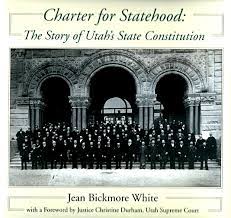Articles/Essays – Volume 32, No. 1
Celebrating Utah’s Centennial | Jean Bickmore White, Charter for Statehood: The Story of Utah’s State Constitution
Charter for Statehood chronicles Utah’s constitutional history from its territorial days through the present. Dr. White, emeritus professor of political science at Weber State University, employs her vast skills in state and local history and constitutional law to tell the often intriguing and occasion ally frustrating tale of Utah’s evolution from the generally distrusted Mormon commonwealth of Deseret through nearly fifty years of undesired territorial status to the final achievement of statehood in 1896.
Readers of Dialogue: A Journal of Mormon Thought may wonder why this book, clearly Utah history not, strictly speaking, Mormon history, is being reviewed here? I pondered this question myself at first. But, in many ways, Utah history and Mormon history are inextricably joined. Simply put: you can’t have one, this reviewer concludes, without the other. True, the physical region that is today’s Utah would exist with or without the Latter-day Saints, but would it really be the same place?
As Jean White makes abundantly clear throughout, the contributions of Mormon culture and beliefs are readily apparent in Utah’s constitutional history from 1847 on. One fascinating aspect of Charter for Statehood which should appeal to both Utah and Mormon historians (it’s my assumption that the two are divisible) is the author’s thorough biographical sketches of the delegates to Utah’s constitutional convention (see the appendix).
A majority of the delegates was, predictably, LDS. The non-Mormons (“gentiles”) were dominated by the presence of mining interests, lawyers, and Protestant clergymen—notably Park City mining magnate Thomas F. Kearns, attorney Dennis Eichnor, and the Rev. George P. Miller, a Methodist Episcopal minister from Sevier County. The Mormon church was rep resented by several high-ranking Moses Thatcher, Presiding Bishop William B. Preston, and Brigham H. Roberts. Smith was unanimously elected to preside over the meeting. Many lower-ranking church leaders were also numbered among the delegates. These varied representatives— wealthy and middle class; Mormon and gentile; farmer, stockman, banker, and merchant alike—all primarily sought the attainment of statehood. None wished, in the author’s words, to “jeopardize” this goal (54).
Of the Utah state constitution, White observes, “it clearly was a product of its time and place” (46). It diligently tried to address issues like the state’s aridity (through favorable land and irrigation laws), concerns over natural resources (particularly water, minerals, and timber), the separation of church and state, and attempted successfully to bridge the often troubling gap between Utah’s Mormon and non-Mormon residents.
White’s concluding chapter, “Fit ting the Constitution to the Future,” addresses many issues of present interest to Utahns—taxation and revenues, funding of public schools, pay for state legislators, and the urban versus-rural distribution of political power and the state’s economic resources. The many efforts at constitutional revision, so evident in the twentieth century, are also treated in this chapter.
Charter for Statehood is generously illustrated with many appropriate, yet relatively unknown, photographs. It contains a selected bibliography of the topic which should prove useful for future students of Utah constitutional history. As part of the University of Utah Press’s Centennial Series, this churchmen like John Henry Smith, book provides a fine addition to the state’s one-hundred-year celebration. Jean Bickmore White and the press are to be congratulated on their efforts. This book makes a solid contribution to the literature of Utah’s statehood centennial.
Charter for Statehood: The Story of Utah’s State Constitution. By Jean Bickmore White. (Salt Lake City: University of Utah Press, 1996).


 Back to full Issue
Back to full Issue

